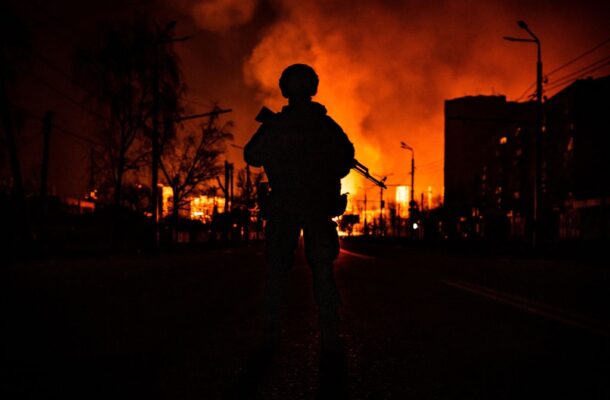A decade of war in Ukraine

In the coming weeks, a flood of analysis can be expected marking the end of the second year of war in Ukraine. In fact, the war began 10 years ago when Russia seized Crimea in February 2014.
This error in analysis demonstrates the cultural challenges Australia, and Western nations more broadly, face in the way they approach defence issues and national security writ large. Our error is that we culturally conflate conventional warfare with war. This is a counter-productive mindset when we are confronted by autocratic leaders who engage in ‘struggle’, perhaps over a decade or longer, using all elements of power.
As the 2024 national security strategy is being written, the lessons of 10 years of war involving political warfare, proxy warfare, grey zone coercion, cyber mobilisation, economic warfare, the development of resistance strategies, the employment of new unmanned systems and conventional warfighting, must be assimilated. In short, we must expand our thinking if we are to holistically understand contemporary war.
Eminent strategist Colin Gray has previously called attention to the erroneous Western conflation of conventional warfare with war. His warning has not been embraced. A manifestation of this Western conflation can be observed in Frank Hoffman’s need to introduce the term, ‘hybrid warfare’, to force a shift in mindset commensurate with the blending of terrorism, guerrilla warfare, and conventional warfare, as displayed by Hezbollah in 2006. This term, ‘hybrid’, became normalised by describing the sophisticated Russian tactics of ‘liminal warfare’ employed during the seizure of Crimea in 2014.
Combat Lessons
The first lesson we might discern from this past decade is that today’s evolved character of war has already adapted to Putin’s escalation in 2022. It punishes the overt employment of conventional warfighting methods thus rewarding political and irregular warfare methods that operate below the threshold of conventional responses through relevant populations, using a mixture of violence and non-violence.
A second lesson of the Russia-Ukraine war is that conventional warfare is risky; almost too risky to be a useful tool of statecraft. Putin sought a decisive end to tensions with Ukraine through a coup de main on 24 February 2022 and he got a decisive effect.
As Kori Shake states: ‘Russia has been taken off the board as a major adversary of the United States’. It is important to note that Putin hoped to avoid further conventional warfighting, as had plagued the Donbas for the past eight years, by seeking to end the confrontation with Ukraine.
It must be recognised that, thus far, the tool of conventional warfighting has failed to deliver Putin any of his strategic objectives. Ironically, the Russian experience looks poised to repeat the Soviet experience of conventional escalation in Afghanistan in 1979. The lesson is that autocratic nations might be expected to continue to pursue grey zone activities and to avoid conventional warfare.
A third lesson is derived by asking why Putin has thus far been denied victory. Ukraine has developed an impressive maritime strike capability using unmanned surveillance and surface vessels that has been under-recognised in Australian strategic discourse.
The sinking of Russia’s Black Sea Fleet flagship, Moskva, in April 2022 and the destruction of a Kilo submarine in drydock in September 2023 were, as the UK First Sea Lord stated, signs that a ‘dreadnought’ moment in the evolution of naval warfare has arrived.
Oddly, the asymmetry inherent in Ukraine’s approach has received little commentary in Australia. The use of low-cost missile and unmanned systems to hold at risk naval platforms in the Black Sea is a model for disrupting naval forces in an archipelagic region like South-East Asia (and is presently being demonstrated off Yemen’s coastline).
Ukraine’s unmanned strike and surveillance systems are also continuing to impose significant cost against land platforms and formations at extended range. Such tactical innovations underpin countries being dissuaded from escalation to conventional warfighting.
Fourth, these Ukrainian innovations began alongside societal responses to Russia’s grey zone activities in the context of a ‘frozen conflict’ in the Donbass. These innovations and adaptions have proven themselves in the ‘hybrid’ nature of conflict from February 2022 to today.
Ukraine decided to develop a capacity for resistance following Russia’s attempts to mobilise subversive elements of Ukraine’s population in April-May 2014 under a ‘Novorossiya’ narrative.
The emergent behaviour shown by physical and virtual resistance efforts in 2022-2023 have proven effective as an asymmetric counter to land power and been adopted broadly across Eastern Europe. Russian political warfare evidently also continues in conflict, demonstrated by efforts to subvert Moldova continuing after February 2022.
The information dimension of the ongoing conflict is global in scale with election interference in this year’s US, UK, and Australian elections almost certainly expected.
The conventional warfighting bias inherent to Western national security system hinders adaptation to these lessons due to the blinkered view of the contemporary character of war.
Lessons for China
The conflation of conventional warfare with war is dangerous as it oversimplifies our challenges and erodes our strategic acumen. Many commentators note that the Chinese Communist Party hasn’t fought a war since the 1979 border incursion against Vietnam, which it arguably lost.
What these commentators mean is that the CCP hasn’t fought a conventional war since 1979. It might be argued that it hasn’t needed to. Following the 1979 Sino-Vietnamese border conflict, the Chinese frustrated Vietnamese influence over Kampuchea in the 1980s by supporting a proxy war waged by the Khmer Rouge from border camps in Thailand.
Following the collapse of the Burmese Communist Party in 1989, Chinese support pivoted to the United Wa State Army (UWSA). With such support, the UWSA have built up control in the Shan state of Myanmar, roughly the size of Belgium.
Over the past decade Chinese maritime militia activities in the South China Sea have arguably secured its island-building fait accompli. Over the past five years, Beijing’s dominance over Hong Kong (and the end of a one state, two systems narrative) was successfully asserted.
To contextualise these events, remember that a century ago, the CCP was a clandestine network predominantly based in Shanghai. It is now the most powerful global competitor to the United States. A patient CCP that has consistently struggled, via a long-term strategy of growing power, is thus under-estimated by a bellicose conventional warfare narrative.
An erroneous understanding of the Russo-Ukraine war betrays a simplistic appreciation of war, clouded by a bias toward conventional warfare. There are, however, important lessons to be drawn from war in Eastern Europe that inform the breadth of future security threats that we are likely to face.
This article was published by The Strategist.
Andrew Maher is a professor of practice at Arizona State University and a lecturer at the UNSW Canberra. He is a director of the grey-zone project with the Irregular Warfare Initiative.












